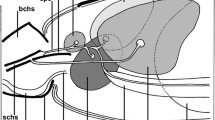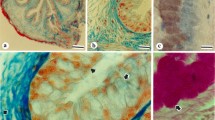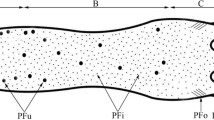Summary
A major function of the larval salivary glands of Drosophila melanogaster is known to be the production of a mucopolysaccharide that serves as an adhesive during puparium formation. In order to localize the mucosubstances during development substrate histochemical methods were used, and the site of acid phosphatase was demonstrated by the ultrahistochemical lead-salt method. It could be shown that the “glue”-granules in the corpus cells of larval salivary glands as well as the large secretion vacuoles in the prepupal corpus cells give a positive β-amylase-resistent PAS-reaction, which indicates neutral mucosubstances. Granular PAS-positive deposits in the larval and prepupal collum cells were reduced after preincubation with β-amylase and may represent glycogen, which has also been seen in electron micrographs of these cells. The Hale-reaction gave a weak indication that acid mucosubstances are present in the larval “glue” granules and in the large prepupal secretory vacuoles. After digestion of sialic acid with α-neuraminidase the weak indication was absent showing that the acid mucosubstances had been sialomucines. Ultrahistochemical demonstration of acid phosphatase indicated the presence of this enzyme in Golgi fields and lysosomal structures. Acid phosphatase seems to be missing in the large secretion vacuoles of the prepupal salivary gland.
It is concluded, that the large vacuoles in the corpus cells of prepupal salivary glands represent a secretion product, obviously a mucosubstance. The lysosomal structures, containing acid phosphatase, may be accumulated in preparation for the autolysis of the gland which begins about two hours after the pupal moult, i.e. 15 hours after puparium formation.
Similar content being viewed by others
References
Ashburner, M.: Patterns of puffing activity in the salivary gland chromosomes of Drosophila. I. Autosomal puffing patterns in a laboratory stock of Drosophila melanogaster. Chromosoma (Berl.) 21, 398–428 (1967)
Ashburner, M.: Patterns of puffing activity in the salivary gland chromosomes of Drosophila. II. The x-chromosome puffing patterns of D. melanogaster and D. simulans. Chromosoma (Berl.) 27, 47–63 (1969a)
Ashburner, M.: Patterns of puffing activity in the salivary gland chromosomes of Drosophila. III. A comparison of the autosomal puffing patterns of the sibling species D. melanogaster and D. simulans. Chromosoma (Berl.) 27, 64–85 (1969b)
Ashburner, M.: Patterns of puffing activity in the salivary gland chromosomes of Drosophila. IV. Variability of puffing patterns. Chromosoma (Berl.) 27, 156–177 (1969c)
Ashburner, M.: Function and structure of polytene chromosomes during insect development. Advanc. Insect Physiol. 7, 1–95 (1970)
Ashburner, M.: Puffing patterns in Drosophila melanogaster and related species. In: Beermann, W. (ed.), Developmental studies with giant chromosomes. Berlin-Heidelberg-New York: Springer 1972
Baker, J. R.: Cytological technique, 2nd ed. London: Methuen 1945
Barka, T., Anderson, P. J.: Histochemistry, theory, practice and bibliography. New York-Evanston-London: Harper and Row, Publ., Inc. 1965
Beaulaton, J.: Modifications ultrastructurales des cellules sécrétrices de la glande prothoracique de vers à soie au cours des deux derniers âges larvaires. II. Le glycogène, ses relations avec le chondriome et le réticulum endoplasmique. J. Micr. 7, 673–692 (1968)
Becker, H. J.: Die Puffs der Speicheldrüsenchromosomen von Drosophila melanogaster. I. Beobachtungen zum Verhalten des Puffmusters im Normalstamm und bei zwei Mutanten. Giant und Lethal-Giant-Larvae. Chromosoma (Berl.) 10, 654–678 (1959)
Becker, H. J.: Die Puffs der Speicheldrüsenchromosomen von Drosophila melanogaster. II. Die Auslösung der Puffbildung, ihre Spezifität und ihre Beziehung zur Punktion der Ringdrüse. Chromosoma (Berl.) 13, 341–384 (1962)
Berendes, H. D.: Salivary gland function and chromosomal puffing patterns in Drosophila hydei. Chromosoma (Berl.) 17, 35–77 (1965)
Bodenstein, D: Factors influencing growth and metamorphosis of the salivary gland in Drosophila. Biol. Bull. 84, 13–33 (1943)
Bodenstein, D.: The postembryonic development of Drosophila. In: Biology of Drosophila (ed. by M. Demerec), p. 275–367. New York and London: Hafner Publishing Company 1950
Brandes, D.: Observation on the apparent mode of formation of “pure” lysosomes. J. Ultrastruct. Res. 12, 63–80 (1965)
Fraenkel, G., Brookes, V. J.: The process by which the puparia of many species of flies become fixed to a substrate. Biol. Bull. 105, 442–449 (1953)
Gaudecker, B. v.: Der Strukturwandel der larvalen Speicheldrüse von Drosophila melanogaster. Ein Beitrag zur Frage nach der steuernden Wirkung aktiver Gene auf das Cytoplasma. Z. Zellforsch. 127, 50–86 (1972)
Gay, H.: Nucleo-cytoplasmic relations in salivary gland cells of Drosophila. Proc. nat. Acad. Sci. 41, 370–375 (1955)
Graumann, W., Claus, W.: Weitere Untersuchungen zur Spezifität der histochemischen Polysaccharid-Eisenreaktion. Acta histochem. (Jena) 6, 1–7 (1958)
Harrod, M. J. E., Kastritsis, C. D.: Developmental studies in Drosophila. II. Ultrastructural analysis of the salivary glands of Drosophila pseudoobscura during some stages of development. J. Ultrastruct. Res. 38, 482–499 (1972a)
Harrod, M. J. E., Kastritsis, C. D.: Developmental studies in Drosophila. VI. Ultrastructural analysis of the salivary glands of Drosophila pseudoobscura during the late larval period. J. Ultrastruct. Res. 40, 292–312 (1972b)
Karnovsky, M. J.: A formaldehyde-glutaraldehyde fixative of high osmolarity for use in electron microscopy. J. Cell Biol. 27, 137A-138A (1965)
Kress, H., Enghofer E.: Kinetic characteristics and ontogeny of glutamine-fructose-6-phosphate aminotransferase in Drosophila salivary glands. Insect Biochemistry, in press (1974)
Lane, N. J., Carter, Y. R., Ashburner, M.: Puffs and salivary gland function: The fine structure of the larval and prepupal salivary glands of Drosophila melanogaster. Wilhelm Roux' Archiv 169, 216–238 (1972)
Lesher, S. W.: Studies on the larval salivary gland of Drosophila. III. The histochemical localization and possible significance of ribonucleic acid, alkaline phosphatase and polysaccharide. Anat. Rec. 114, 633–652 (1952)
Lev, R., Spicer, S. S.: Specific staining of sulfate groups with alcian blue at low pH. J. Histochem. Cytochem. 12, 309 (1964)
Lillie, R. D.: Histopathologic technic and practical histochemistry, 3rd ed. New York-Toronto-Sydney-London: McGraw-Hill Book Co. 1965
Matsuura, S., Morimoto, T., Nagata, S., Tashiro, Y.: Studies on the posterior silk gland of the silkworm, Bombyx mori. II. Cytologie process in posterior silk gland cells during metamorphosis from larva to pupa. J. Cell Biol. 38, 589–603 (1968)
Miller, F., Palade, G.: Lytic activities in renal protein absorption droplets. An electron microscopical study. J. Cell Biol. 23, 519–552 (1964)
Novikoff, A. B., Essner, E.: Cytolysomes and mitochondrial degeneration. J. Cell Biol. 15, 140–146 (1962)
Osinchak, J.: Ultrastructural localization of some phosphatases in the prothoracic gland of the insect Leucophaea moderae. Z. Zellforsch. 72, 236–248 (1966)
Poels, C. L. M., Loof, A. de, Berendes, H. D.: Functional and structural changes in Drosophila salivary gland cells triggered by ecdysterone. J. Insect Physiol. 17, 1717–1729 (1971)
Richardson, K. C., Jarett, L., Finke, E. H.: Embedding in epoxy resins for ultrathin sectioning in electron microscopy. Stain Technol. 35, 313–323 (1960)
Ross, E. B.: The post-embryonic development of the salivary glands of Drosophila melanogaster. J. Morph. 65, 471–495 (1939)
Scharrer, B.: An ultrastructural study of cellular regression as exemplified by the prothoracic gland of Leucophaea moderae (Abstract). Anat. Rec. 151, 411 (1965)
Scharrer, B.: Ultrastructural study of the regressing prothoracic glands of blattarian insects. Z. Zellforsch. 69, 1–21 (1966)
Smith, R. E., Farquhar, M. G.: Lysosome function in the regulation of the secretory process in cells of the anterior pituitary gland. J. Cell Biol. 31, 319–347 (1966)
Smith, W. G., Witkus, E. R.: Secretory development in larval Drosophila salivary glands. J. Cell Biol. 47, 196a-197a (1970)
Author information
Authors and Affiliations
Additional information
This investigation was supported by grants from the Deutsche Forschungsgemeinschaft (Ga 97/6).
Rights and permissions
About this article
Cite this article
von Gaudecker, B., Schmale, EM. Substrate-histochemical investigations and ultrahistochemical demonstrations of acid phosphatase in larval and prepupal salivary glands of Drosophila melanogaster . Cell Tissue Res. 155, 75–89 (1974). https://doi.org/10.1007/BF00220285
Received:
Issue Date:
DOI: https://doi.org/10.1007/BF00220285




